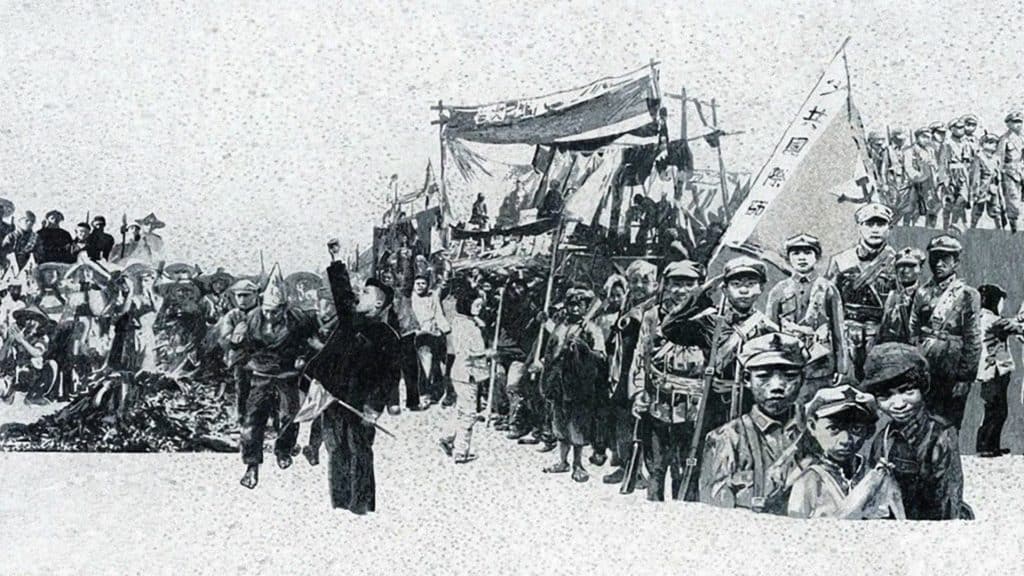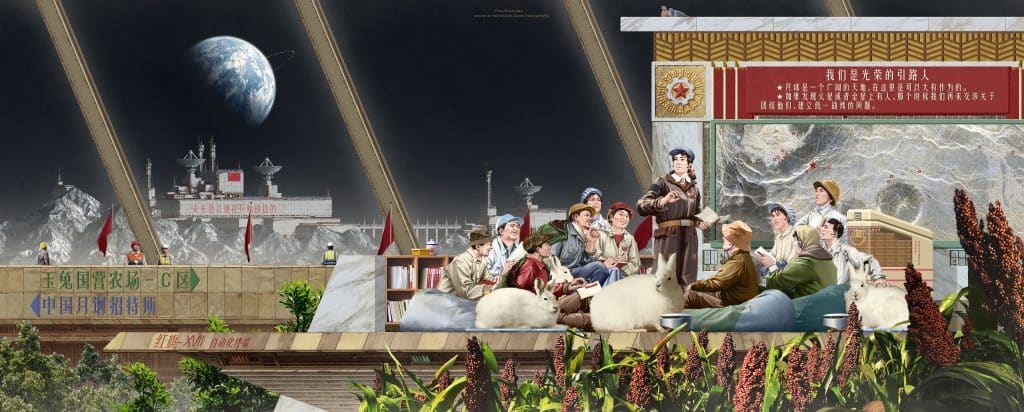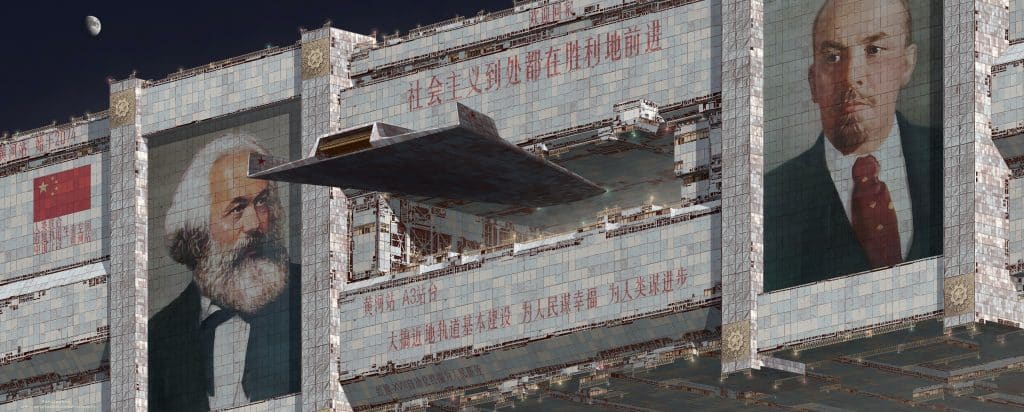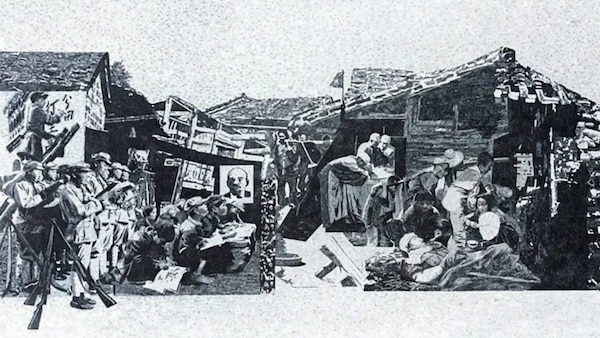Dear friends,
Greetings from the desk of Tricontinental: Institute for Social Research.
Seventy-five years ago, on 1 October 1949, Mao Zedong (1893–1976) announced the creation of the People’s Republic of China (PRC). It is important to note that the Communist Party of China (CPC) did not name the new state the SocialistRepublic, but instead called it the People’s Republic. That is because Mao and the CPC did not foresee China being immediately ushered into socialism; rather, the country was embarking on the road to socialism, a process that would likely take decades, if not a century. That was very clear to the people who began to shape the new state and society. The People’s Republic would have to be built out of the embers of a very long war, one that began when the Japanese invaded northern China in 1931 and that lasted for the next 14 years and took the lives of over 35 million people. ‘From now on our nation will belong to the community of the peace-loving and freedom-loving nations of the world’, Mao said at the first plenary session of the Chinese People’s Political Consultative Conference on 21 September 1949. The new China, he continued, will ‘work courageously and industriously to foster its own civilisation and well-being and at the same time to promote world peace and freedom. Ours will no longer be a nation subject to insult and humiliation. We have stood up’.
Mao’s words echoed the sentiments of anti-colonial movements from around the world, including those of leaders of movements that were not socialist, such as Jawaharlal Nehru of India and Gamal Abdel Nasser of Egypt. For them, the decolonisation process required world peace and equality so that the formerly colonised people of the world could stand up and build their lives with dignity. Reading and reflecting upon these words in 2024 allows us to appreciate both the advances made by the world’s peoples since 1949 and the obstinacy of the old colonial powers that have long sought to prevent this new world from being built. The ongoing US-Israeli genocide against Palestinians and bombardment of Lebanon reflect the barbarousness to which the colonial powers are willing to resort as they attempt to hold us in this past that we want to transcend. The attitudes and wars imposed by the old colonial powers divert us from building our ‘own civilisation and well-being’ and from promoting ‘world peace and freedom’. Mao’s words, which are really the words of all people emerging from colonialism, offer the world a choice: either we live as adversaries with our resources poured into ugly and meaningless wars or we build a ‘community of peace-loving and freedom-loving nations of the world’.

Detail of: Ye Wulin (China), 红星颂 (Ode to the Red Star), 2015.
The average life expectancy in the PRC – 77 years – exceeds the global average by four years, coming a long way from 1949, when the figure was a mere 36 years. This is one of many indicators of a society that prioritises the well-being of people and the planet. Another was explained to me by a Chinese official a few years ago, who told me about how his country planned to create a post-fossil fuel economy soon. The word ‘soon’ interested me, and I asked him how it would be possible to do something of that nature so quickly. He began to tell me about the importance of planning and marshalling resources but, when he realised that I was not asking him about the strategy for this new economy but about the timeframe, said that this could be done ‘within the next half century, maybe, if we work hard, by [2049,] the hundredth anniversary of the formation of the PRC’. The confidence in the PRC allows for this kind of long-term planning, rather than the short-term compulsions imposed on states by the logic of capitalism. This long-term attitude pervades Chinese society, and it allows the CPC the luxury to harness resources and plan decades into the future, rather than mere months or years.
It was this sort of thinking that gripped Beijing’s city managers over twenty years ago, when the rapid rise of automobiles in the capital and the burning of coal to generate heat enveloped the population in toxic smog. The national five-year plans for 2001–2005 and 2011–2015, as well as Beijing’s own Five-Year Clean Air Action Plan (2013–2017), made it clear that economic growth could not ignore the environment. The city managers began to centre their planning around public transportation and transit corridors rooted in an older Chinese urban design that built shops and apartment buildings in a way that would promote walking rather than driving. In September 2017, the city established low-emission zones to prevent polluting vehicles from entering Beijing and created incentives for the use of new energy vehicles, which are powered by electric energy. China owns 99 percent of the world’s 385,000 electric buses, 6,584 of which are on Beijing’s streets. Though there is still a long way to go for Beijing’s air to meet its own standards, the toxicity of the air has noticeably declined.

Fan Wennan (China), 嫦娥同志 (Comrade Cháng’é), 2022.
In Mao’s founding speech in 1949, he declared that one of the PRC’s goals would be to foster the people’s well-being. How is it possible to do that within a neocolonial world system that enforces the poorer nations’ dependency on the former colonial powers? In the global production chain, the poorer nations produce goods at a lower cost, with wages and consumption suppressed, which allows multinational corporations (MNCs) to sell commodities for higher prices around the world and earn larger profits. These large profits are then invested by the MNCs to develop new technologies and productive forces that reinforce the permanent subordination of the poorer nations. If a poor nation exports more goods in an attempt to earn higher returns, it simply digs itself into a deeper and deeper spiral of lowered living standards for its exploited workers and into a debt trap that simply cannot be exited. It is one thing to be able to plan, but how does one acquire the resources to execute a plan?
At Tricontinental: Institute for Social Research, we have been looking closely at the experience of China and other countries in the Global South that have attempted to rattle this cage of dependency. As Tings Chak and I show in an article on the 75th anniversary of the PRC, in its first decades China marshalled whatever minimal resources were available to it, including assistance from the Soviet Union, to build a new agricultural system against landlordism, create an education and health system that improved the people’s quality of life, and fight against the wretched hierarchies of the past. That first phase, from 1949 to the late 1970s, endowed China with a culture that is far more egalitarian and a population that is far more educated and in better health than those in other post-colonial states. It is the CPC’s commitment to transform people’s lives that created this possibility. In the second phase, from 1978 to the present, China has used its large labour force to attract foreign investment and technology, but it has done so in a way that ensures that science and technology will be transferred to China and that the state’s control over exchange rates will allow the CPC to raise wages (which were improved by the 2008 Labour Contract Law), avoid the middle-income trap, enhance technological capabilities, and drive state-owned enterprises to develop high-tech productive systems. That is what accounts, in large measure, for the rapid growth that China has experienced over the past decades and its ability to lift up the well-being of its population and environment within the overall structure of the neocolonial world system.

Fan Wennan (China), 中国2098: 欢迎回家 (China 2098: Welcome Home), 2019–2022.
In April 2017, the Xiong’an New Area (roughly 100 kilometres south of Beijing) was officially established to accommodate five million residents in order to relieve the emergent congestion in Beijing, whose growing population of 22 million faces serious problems of scale. This is being done, for instance, by absorbing many of the non-government institutions that are currently located in the capital city (among them research, higher education, medical, and financial institutions). One of the key motivations for the construction of the Xiong’an New Area was to address the plights facing the densely populated capital without embarking on urban reconstruction that could ruin the character of this city that first emerged in 1045 BCE.
To take advantage of the clean slate afforded by building this new city, PRC officials set a zero-carbon emissions target for the Xiong’an New Area, its landscape defined by the blue-green hues of water and vegetation rather than the grey smog of a concrete jungle. The first priority as the city was planned was to rehabilitate the Baiyangdian, the largest wetland in northern China. Its water area, known as the ‘kidney of North China’, was expanded from 170 square kilometres to 290 square kilometres; its water quality was improved from Class V (unusable) to Class III (able to drink); and the critically endangered diving duck Baer’s pochard was settled in the area and now thrives on the lake. The Baiyangdian anchors the city.
The Xiong’an New Area is being built as ‘three cities’: a city above ground; an underground city of commercial centres, transportation, and pipelines (for fibre optic cables, electricity, gas, water, and sewage); and a cloud-based city that will provide data for smart transportation, digital governance, intelligent equipment inspection, elderly monitoring, and emergency response. As the National Development and Reform Commission of Hebei Province’s January report describes, the Xiong’an New Area is:
creat[ing] an urban ecological space where city and lake coexist, where city and greenery are integrated, and where forests and water are interdependent… [It e]mphasise[s] the integration of greenways, parks, and open spaces to create a city with parks within cities and cities within parks, where people can live and enjoy nature.
Seventy-five years into its revolutionary process, China has indeed made rapid advances, though it will have to settle the many new problems that have emerged (which you can read about in the international edition of the journal Wenhua Zongheng, or 文化纵横). China’s feat of shaking the chains of dependency is worthy of detailed debate, perhaps while walking along the Baiyangdian Lake in the Xiong’an New Area.
Warmly,
Vijay

